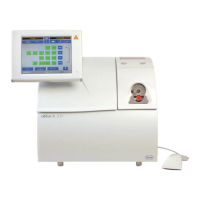Roche Diagnostics May 2009
B-78 Service Manual · Version 9.0
4 Components cobas b 221 system
Vacuum system
Replacing the vacuum pump protector
1
Unscrew the five screws holding the left side panel of the cobas b 221 system and
remove the side panel.
2
Disconnect the two tubes and the sensor on the vacuum pump protector.
e
For details, see Figure B-58 on page B-75.
3
Loosen the two screws holding the vacuum pump protector by unscrewing them
out about 1 cm.
4
Pull the vacuum pump protector up and remove it.
Use the reverse order for assembly.
Replacing the VP tube set
1
Switch off cobas b 221 system and open bottle compartment cover.
2
Remove the top cover and T&D cover of the cobas b 221 system.
3
Rotate the T&D lock on the T&D module 90 degrees to the right.
e
For details, see Figure B-4 on page B-22.
4
Carefully pull the sample inlet path out to the right and remove it.
5
Unscrew the three screws holding the central measuring unit
e
For details, see Figure B-2 on page B-20.
Various components of the cobas b 221 system, such as T&D module, tubes, waste bottle, waste
separator etc., contain liquid biological residues after use that may cause infection.
Handle these components with care and avoid skin contact. To avoid direct contact with biological
materials, always wear appropriate protective equipment such as lab clothing, protective gloves,
safety glasses and, if necessary, a face mask. Additionally a face shield must be worn if there is a
potential of a splashback. Appropriate disinfection and sterilization procedures must be followed.
Always wear gloves when working with the instrument! The tubes may drip a little after being
disconnected. Remove excess fluids with a clean, absorbent cloth.
Do not remove the fastening screws completely, because they are secured against loss.
Various components of the cobas b 221 system, such as T&D module, tubes, waste bottle, waste
separator etc., contain liquid biological residues after use that may cause infection.
Handle these components with care and avoid skin contact. To avoid direct contact with biological
materials, always wear appropriate protective equipment such as lab clothing, protective gloves,
safety glasses and, if necessary, a face mask. Additionally a face shield must be worn if there is a
potential of a splashback. Appropriate disinfection and sterilization procedures must be followed.
Always wear gloves when working with the instrument! The tubes may drip a little after being
disconnected. Remove excess fluids with a clean, absorbent cloth.

